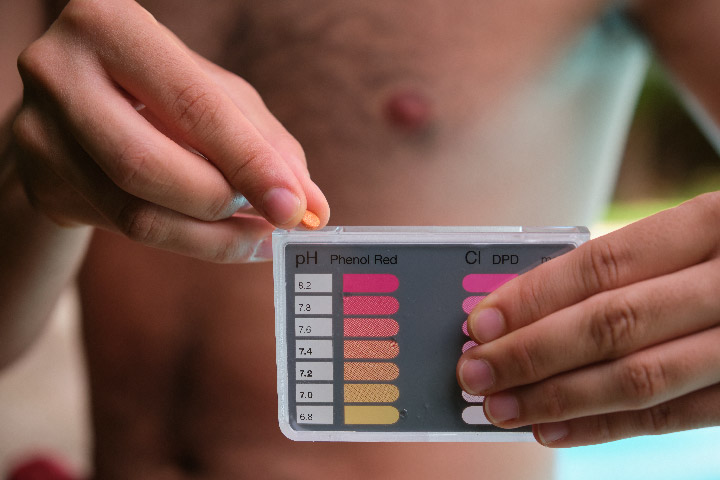Keep Your Pool Safe and Crystal Clear by Understanding and Addressing Low Chlorine Levels
Introduction
Chlorine is an essential chemical for maintaining a clean, safe, and healthy swimming pool. It acts as a sanitizer, killing bacteria, algae, and other harmful microorganisms. However, constantly low chlorine levels can result in an unclean pool and various problems. This article will explore the causes of low chlorine levels, the role of stabilizers, chlorine lock, and combined chlorine, and provide troubleshooting steps and solutions to address this issue.
Causes of High Chlorine Demand
Several factors can contribute to high chlorine demand and low chlorine levels in your pool:
- High pool usage: An increase in swimmers can deplete chlorine levels more rapidly.
- Excessive organic debris: Leaves, grass, and other organic material can increase chlorine demand.
- Algae growth: Algae consume chlorine, leading to a decrease in sanitizer levels.
- Improper water balance: Incorrect pH, alkalinity, or calcium hardness levels can affect chlorine’s effectiveness.
- Insufficient sunlight protection: Sunlight can break down chlorine, reducing its effectiveness as a sanitizer.
The Role of Stabilizer, Chlorine Lock, and Combined Chlorine
- Stabilizer: Also known as cyanuric acid, stabilizers protect chlorine from sunlight degradation, extending its lifespan in the pool. However, high levels of stabilizer can reduce chlorine’s effectiveness.
- Chlorine lock: This occurs when high levels of stabilizer prevent free chlorine from sanitizing the pool effectively, resulting in low chlorine levels despite regular dosing.
- Combined chlorine: When chlorine binds with contaminants, it forms combined chlorine, which is less effective as a sanitizer. High levels of combined chlorine can contribute to low free chlorine levels.
Problems Resulting from Constantly Low Chlorine
Constantly low chlorine levels can lead to several issues in your pool, such as:
- Algae growth: Without sufficient chlorine, algae can thrive, turning your pool water green and murky.
- Bacterial growth: Low chlorine levels can result in the proliferation of harmful bacteria, posing health risks to swimmers.
- Cloudy water: Insufficient chlorine can cause pool water to become cloudy and uninviting.
- Foul odors: Combined chlorine can produce a strong, unpleasant chlorine smell.
Troubleshooting Steps
- Test your pool water: Regularly test your pool water for chlorine levels, pH, alkalinity, and stabilizer levels. This will help you identify the cause of low chlorine levels.
- Inspect your pool equipment: Ensure your pool pump, filter, and chlorinator are functioning correctly.
Solutions for Fixing Low Chlorine Levels
- Shock the pool: Perform a pool shock treatment with a high dose of chlorine to address algae growth, bacteria, and combined chlorine.
- Adjust the stabilizer levels: Lower high stabilizer levels by partially draining and refilling your pool with fresh water. Maintain the recommended stabilizer levels to prevent chlorine lock.
- Balance your pool water: Ensure your pool water is balanced by adjusting the pH, alkalinity, and calcium hardness levels as needed.
- Optimize your chlorinator settings: Adjust your chlorinator settings to increase the rate of chlorine production or dosing.
- Remove organic debris: Regularly skim, vacuum, and brush your pool to remove leaves, grass, and other debris that can contribute to high chlorine demand.
- Use an algaecide: Regularly use an algaecide to prevent algae growth and maintain optimal chlorine levels.
Conclusion
Constantly low chlorine levels in your backyard swimming pool can lead to several problems, including algae growth, bacterial contamination, and cloudy water. Understanding the causes of low chlorine levels, such as high chlorine demand, the role of stabilizers, chlorine lock, and combined chlorine, is essential in maintaining a clean and safe pool environment.
By implementing proper troubleshooting steps and solutions, such as shocking the pool, adjusting stabilizer levels, balancing pool water, optimizing chlorinator settings, removing organic debris, and using algaecides, you can effectively address and prevent low chlorine levels. Regular pool maintenance and water testing will help you keep your pool crystal clear and ready for swimming all season long.
